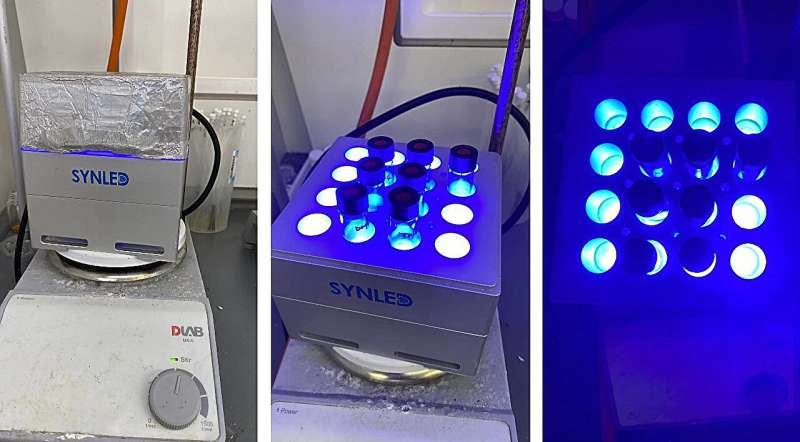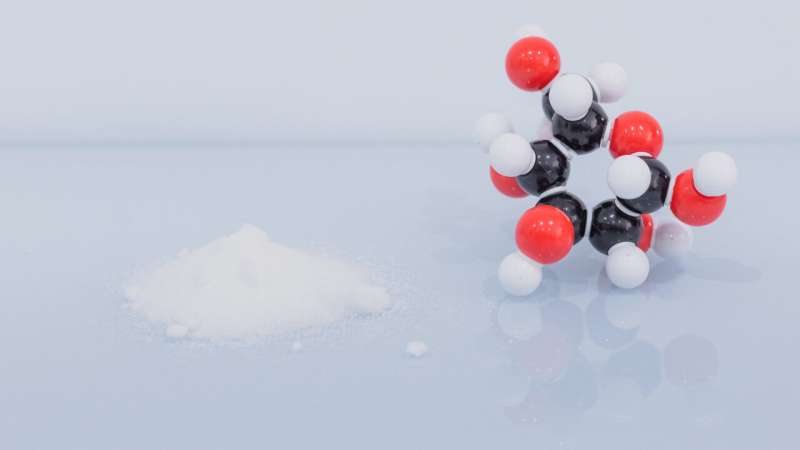This article has been reviewed according to Science X's editorial process and policies. Editors have highlighted the following attributes while ensuring the content's credibility:
fact-checked
peer-reviewed publication
trusted source
proofread
Boosting the synthesis of stable sugar compounds with a novel nature-inspired approach

Researchers from the National University of Singapore (NUS) have developed a new biomimetic concept to convert naturally occurring sugars into diverse classes of stable glycosides and glycoproteins without using protecting-group chemistry. This innovation promises to accelerate carbohydrate synthesis and post-translational protein modification, with potential applications for the pharmaceutical, cosmetic and biotechnology sectors.
The research team was led by Associate Professor Koh Ming Joo from the NUS Department of Chemistry, in collaboration with Professor Benjamin G. Davis from the Rosalind Franklin Institute and the University of Oxford, United Kingdom. Their research breakthrough was published in the journal Nature on 19 June 2024.
Carbohydrates play indispensable roles in biological processes, and the simple attachment of a glycosyl moiety often adds desirable functions. Due to their importance, considerable efforts have been devoted to synthesizing these carbohydrates and their derivatives to better understand their properties and functions, as well as to develop sugar-based drugs, skincare ingredients and other valuable products.
In particular, C-glycosyl compounds have gained prominence as metabolically stable and often more biologically potent mimics of O-glycosides.
However, the chemical synthesis of C-glycosyl compounds has traditionally been plagued by the need for multi-step protecting-group strategies and harsh conditions, which generate excessive waste. This is because native sugars contain multiple hydroxyl groups of similar reactivity, making it difficult to selectively react with them without using protecting groups. For many years, the practical inefficiencies of these approaches have limited their use in synthetic glycochemistry and in conditions requiring high biocompatibility.
Assoc Prof Koh said, "Many research groups, including ours, have endeavored tirelessly to conceive a protecting-group-free chemical glycosylation approach that can directly transform native sugars into the desired glycosides by selective functionalization at the anomeric position. However, this has proven to be extremely challenging."

Nature-inspired 'cap and glycosylate' technology
Enzymes known as glycosyltransferases are highly proficient in mediating site-selective glycosylations at the anomeric carbon without having to protect the remaining hydroxyl groups. The researchers took a page from nature by designing a biomimetic chemical approach that preferentially activates and substitutes the anomeric hydroxyl group in a native sugar with a nucleophilic thiol (a process referred to as capping).
This generates a temporary thioglycoside intermediate that, under photoinduced conditions, undergoes stereocontrolled desulfurative cross-coupling with a suitable reagent (a process referred to as glycosylation). Similar to nature, this 'cap and glycosylate' strategy converts native sugars into glycosides in a single operation.
To demonstrate the broad applicability of this technology, the researchers synthesized densely functionalized C-glycosyl, S-glycosyl, Se-glycosyl and O-glycosyl compounds. Beyond small-molecule glycosylation, the method can be extended to complex biomolecules.
Previously, post-translational chemical glycosylation of proteins by direct anomeric functionalization of native sugars was challenging and largely unexplored. In the new work, C-glycosylation of four proteins of different sizes and folds was successfully achieved, underscoring the power of the "cap and glycosylate" approach.
Prof Davis said, "Our group has spent a number of years exploring the idea of inserting information into biological molecules such as proteins and sugars to alter their function. One of the things that we have found is that carbon-centered radicals are wonderfully useful yet benign reactive intermediates for achieving new chemistries in biological systems.
"In this research, by generating free glycosyl radicals as intermediates directly from native sugars, we are trying to mimic what is happening in biology to make the synthesis of these glycosides and glycoproteins far more efficient. This efficient 'harvesting' of native sugars that can be plugged directly into new glycoconjugates has the potential to open up a number of different avenues including the development of diverse sugar-based therapeutics."
"We believe that this biomimetic 'cap and glycosylate' technology would pave the way towards modernizing carbohydrate and glycoconjugate synthesis without the need for protecting-groups. This would bring enormous benefits in saving costs, time and manpower, empowering researchers to rapidly access saccharides and offering a practical platform to introduce fully unprotected glycosyl groups into biological systems," added Assoc Prof Koh.
More information: Yi Jiang et al, Direct radical functionalization of native sugars, Nature (2024). DOI: 10.1038/s41586-024-07548-0
Journal information: Nature
Provided by National University of Singapore





















